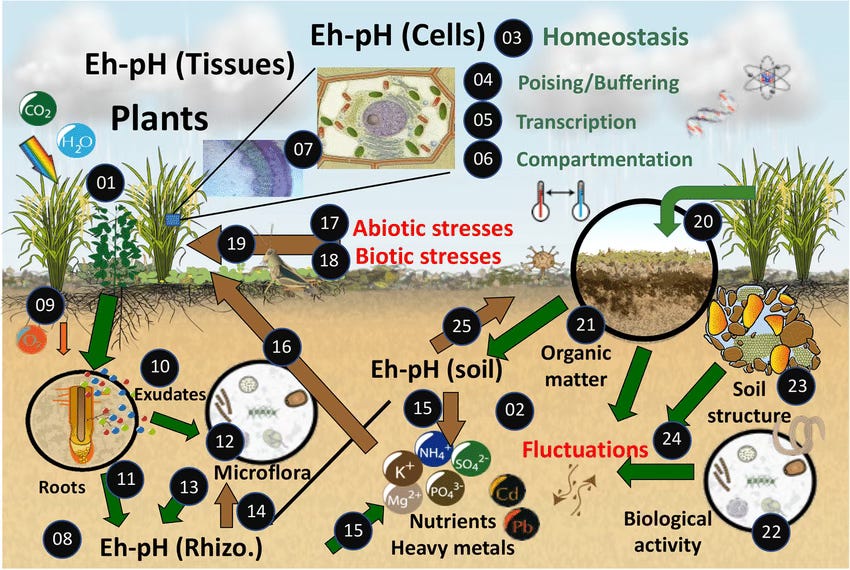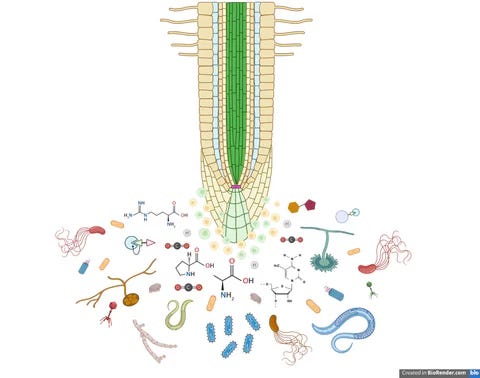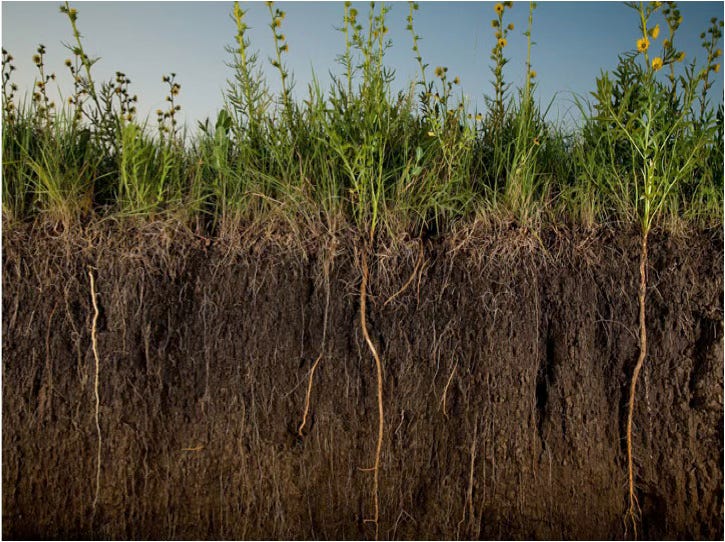The Bioelectrical Basis of Soil
Recognizing the Fourth Dimension of Soil Science Beyond Physical, Chemical, and Biological Properties
Soil functions as a complex electrochemical matrix where electron transfer processes govern nutrient availability, microbial activity, and plant physiological responses. Understanding and managing this electrical dimension represents an emerging frontier of agricultural science. This electrical activity is measured as redox potential (Eh), which quantifies the electron activity or pressure in the system. Eh ranges from highly oxidized (+600 mV) to highly reduced (-300 mV). This invisible electrical gradient determines which nutrients plants can access by controlling the oxidation state of elements and therefore their solubility, mobility, and bioavailability.
Think of soil redox like climate zones: different microbial communities thrive in specific electrical environments, just as distinct plant communities occupy tropical, temperate, or arctic regions. Each zone supports specialized metabolic pathways, and the electrical state of soil directly determines which nutrients are "switched on" for plant uptake.
Phosphorus—critical for plant energy systems—reaches peak availability between 150-200 mV, a sweet spot achieved by balanced management practices. Plants growing in electrically balanced soils develop superior nutritional profiles. Field measurements show crops from soils with stable redox conditions (±75 mV fluctuation) contain higher mineral concentrations than those from unstable systems (±175 mV).
The Rhizosphere as an Electrochemical Interface
Living roots dramatically influence soil electricity. Deep-rooted plants can alter redox conditions throughout the soil profile, while legumes create unique electrical microsites with conditions favorable for nitrogen-fixing bacteria. These plant-induced redox environments function as specialized ecological niches that selectively cultivate beneficial microbial communities.
The rhizosphere functions as a dynamic electrochemical interface where carbon compounds exuded from roots serve as electron donors, establishing redox gradients that influence microbial community composition and metabolic activity. Research demonstrates that plants allocate 20-40% of their photosynthetically fixed carbon to root exudates, effectively "spending" this energy to cultivate specific electrochemical conditions that favor certain microbial partnerships. This carbon investment represents a sophisticated evolutionary strategy that optimizes nutrient acquisition through bioelectrical manipulation.
Managing Soil Electricity
Minimizing soil disturbance preserves these natural electrical gradients. Growing diverse plants prevents extreme electrical conditions. Research shows that diverse plantings typically maintain redox fluctuations within narrower ranges (±100 mV) compared to monocultures which demonstrate more dramatic swings (±200 mV) with corresponding nutrient imbalances.
Cover crop mixtures combining species with different rooting architectures can create complementary electrical niches throughout the soil profile. Research indicates that diverse plant communities can support greater microbial biomass and correspondingly higher rates of nutrient cycling, effectively transforming deeper soil layers from static mineral repositories into biologically active, nutrient-generating zones.
Water management plays a critical role in maintaining optimal soil electrical conditions. Proper irrigation timing can help maintain redox potentials within ideal ranges for specific crops. Studies have demonstrated that strategic water management approaches can achieve significant water savings while maintaining crop yield and quality benchmarks, particularly in water-limited environments.
How Soil Electricity Affects Carbon and Greenhouse Gases
Nobel Laureate Albert Szent-Györgyi perfectly captured this connection: "What drives life is a little electric current, kept up by the sunshine." This electrical perspective helps explain variation in productivity observed between similar agricultural systems—soil electrical conditions may function as a previously underrecognized yield-limiting factor.
The electrochemical properties of soil also influence atmospheric gas exchange and climate impact. Proper redox management reduces nitrous oxide emissions, with well-managed systems achieving lower greenhouse gas intensities compared to electrically imbalanced soils. Research from agricultural institutions indicates that maintaining appropriate redox potentials can substantially reduce nitrous oxide emissions compared to conventionally managed systems that oscillate between waterlogged and desiccated conditions.
Carbon sequestration capacity is similarly influenced by soil electrical properties. Soils with stable redox conditions in the +150 to +300 mV range demonstrate greater carbon stabilization rates than soils that experience frequent redox extremes. This relationship helps explain why certain management systems accumulate soil carbon more efficiently than others, even when organic inputs are similar. The electrical environment determines whether added carbon is metabolized into atmospheric CO₂ or transformed into stable soil organic matter components with longer residence times.
Managing Soil as an Electrical Whole
This electrochemical perspective explains why singular "silver bullet" interventions often fail while integrated approaches succeed. Optimal soil electrical conditions require coordinated management of carbon, physical structure, water, and microbial communities. By creating conditions that optimize energy transfer from sun to soil to plant to plate, we can achieve higher quality food and more resilient production systems.
The bioelectrical dimension of soil functions provides a unifying framework that integrates traditionally separate aspects of agricultural management. Rather than viewing soil fertility, irrigation, tillage, and crop diversity as independent management decisions, the electrochemical perspective reveals them as interconnected components of a single system optimizing energy capture and transfer.
Regenerative practices like adaptive multi-paddock grazing demonstrate this principle in action. Properly timed grazing events influence soil electrical conditions through defoliation-induced root exudation pulses, effectively supporting soil electrical systems while preventing the redox stagnation that occurs in both continuously grazed and ungrazed systems. Monitored paddocks show redox fluctuations that follow beneficial patterns, creating alternating windows of opportunity for different beneficial microbial guilds while avoiding detrimental extremes.
Practical Applications and Future Directions
This emerging understanding of soil as an electrochemical system offers practical applications across agricultural contexts. Field measurements with portable redox probes can guide management decisions, from determining optimal planting dates to adjusting irrigation schedules. Progressive producers have begun incorporating redox monitoring into their decision protocols, resulting in more precise management of inputs.
While conventional agriculture has focused on overriding natural nutrient cycles through chemical inputs, the electrochemical framework suggests an alternative: creating conditions where beneficial soil processes self-organize and self-perpetuate. This approach requires a shift from reactive intervention to proactive system design, but offers the possibility of agricultural systems that continuously improve rather than degrade over time.
As measuring instruments become more accessible and our understanding of soil electricity grows, we stand at the threshold of a new agricultural paradigm where management decisions are guided by the invisible but powerful electrical dimensions of the soil ecosystem. By aligning our practices with these fundamental energetic principles, we can create production systems that efficiently capture, store, and transfer energy while building rather than depleting natural capital.
References
Badri, D. V., & Vivanco, J. M. (2009). Regulation and function of root exudates. Plant, Cell & Environment, 32(6), 666-681.
Husson, O. (2013). Redox potential (Eh) and pH as drivers of soil/plant/microorganism systems: a transdisciplinary overview pointing to integrative opportunities for agronomy. Plant and Soil, 362(1), 389-417.
Jones, D. L., Nguyen, C., & Finlay, R. D. (2009). Carbon flow in the rhizosphere: carbon trading at the soil–root interface. Plant and Soil, 321(1), 5-33.
Lal, R. (2004). Soil carbon sequestration impacts on global climate change and food security. Science, 304(5677), 1623-1627.
McBride, M. B. (1994). Environmental chemistry of soils. Oxford University Press.
Patrick, W. H., & Jugsujinda, A. (1992). Sequential reduction and oxidation of inorganic nitrogen, manganese, and iron in flooded soil. Soil Science Society of America Journal, 56(4), 1071-1073.
Paustian, K., Lehmann, J., Ogle, S., Reay, D., Robertson, G. P., & Smith, P. (2016). Climate-smart soils. Nature, 532(7597), 49-57.
Pezeshki, S. R., & DeLaune, R. D. (2012). Soil oxidation-reduction in wetlands and its impact on plant functioning. Biology, 1(2), 196-221.
Teague, W. R., Dowhower, S. L., Baker, S. A., Haile, N., DeLaune, P. B., & Conover, D. M. (2011). Grazing management impacts on vegetation, soil biota and soil chemical, physical and hydrological properties in tall grass prairie. Agriculture, Ecosystems & Environment, 141(3-4), 310-322.
Tilman, D., Isbell, F., & Cowles, J. M. (2014). Biodiversity and ecosystem functioning. Annual Review of Ecology, Evolution, and Systematics, 45, 471-493.
Venterea, R. T., Maharjan, B., & Dolan, M. S. (2012). Fertilizer and irrigation management effects on nitrous oxide emissions and nitrate leaching. Journal of Environmental Quality, 41(5), 1507-1519.





Conductivity also has relations to salinity, I had in an eadphology exam one exercise where you used formulas to use whatever amount of Siemens to see how salty the soil was.
I saw anecdotically that there was an experiment in Japan where a small machine in the forest conducted small charges over spots in the ground, imitating lightning, and that mushrooms grew more abundantly on those regions. Could soil electricity also have a hand in mushroom yield?
Great stuff here Sam, Have you read Matt Powers book called "Regenerative Soil: The Science & Solutions"?
He offers some great content on this often over looked dimension of soil life.